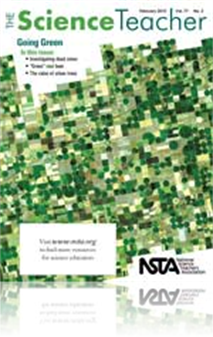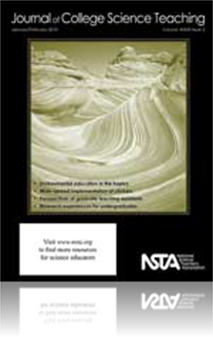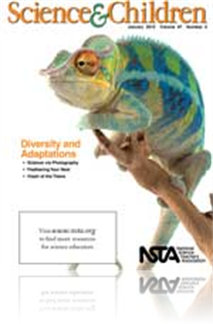All Resources
Journal Article
Scope on Safety: Digging up the dirt on soil safety
Should middle school science teachers be concerned about students bringing in unknown sources of soil to work on in class as the activity suggests? The science is well intended, but is it safe? What are some possible safety issues that might be of co...
Journal Article
Methods and Strategies: Using Learning Progressions to Monitor Progress Across Grades
Learning progressions (LPs)—descriptive continuums of how students develop and demonstrate more sophisticated understanding over time—have become an increasingly important tool in today’s science classrooms. Here the author discusses some of th...
Journal Article
The Prepared Practitioner: Groundwater—A Green Issue
This issue’s theme—“Going Green”—relates to environmental education. In an article published in the Journal of Science Teacher Education, Dickerson and colleagues (2007) discuss issues related to the lack of groundwater education in school ...
Journal Article
The National Science Education Teaching Standards state that students should be provided with opportunities to use resources outside the classroom (Standard D; NRC 1996). Involving parents in learning, including informal learning sites, and tapping i...
Journal Article
Scope on the Skies: End of the line for a star like ours
Stars of different masses have varying life spans, with the more massive stars “burning out” more quickly than stars of lower masses. How or what they do when they burn out also varies, depending on the mass of the star. All stars are called main...
Journal Article
For a science teacher in a city, it can sometimes be a challenge to find curricula that are geared specifically toward urban students. The author tackled this dilemma by creating a unit that focused on the urban surroundings experienced by his second...
Journal Article
Idea Bank: Two Green Thumbs Up!
Teaching with movie clips is one strategy to increase student understanding of environmental science. Whether accurate or not, “movie science” can expose students to phenomena that are difficult to explore in the typical classroom. In addition, a...
Journal Article
Natural Resources: Outdoor Classrooms
An outdoor classroom is the ideal vehicle for community involvement: Parents, native plant societies, 4-H, garden clubs, and master naturalists are all resources waiting to be tapped, as are local businesses offering support. If you enlist your commu...
Journal Article
Investigating Aquatic Dead Zones
This article features two engaging high school activities that include current scientific information, data, and authentic case studies. The activities address the physical, biological, and chemical processes that are associated with oxygen-depleted ...
Journal Article
From Mystery Seed to Mangrove Island
Introducing a mystery object is an easy strategy to implement and allows teachers to pre-assess students’ knowledge about local natural resources. Misconceptions can be noted as teachers record initial inquiries and wonderings on charts. Using the ...
Journal Article
Agriculture can play a key role in fostering scientific literacy because it brings important plant and ecosystem concepts into the classroom. Plus, agriculture, like science, is not static and includes much trial and error, investigation, and innovat...
Journal Article
Teaching Through Trade Books: How It’s Made
Your students are most likely not knowledgeable about the raw materials, the design processes, and the technology involved in manufacturing the products they use everyday. Making connections with local manufacturers can connect students to the real s...
Journal Article
Visual formative assessments (VFAs) allow more free more time for direct instruction. VFA’s guide students in using simple images to demonstrate the essential learnings within a unit to themselves and the teacher. VFAs are powerful because they eng...
Journal Article
The Ocean, Reefs, Aquariums, Literacy, and Stewardship (CORALS) research program helps students connect global environmental issues to local concerns and personal choices. During the 18-week program, students strengthen their understanding of coral r...
Journal Article
The day the Turtle Girls received Montel’s adoption papers, piercing screams ricocheted across the school grounds instantaneously and simultaneously—in that moment, each student felt the joy of civic stewardship. Read on find out how a visit to T...
Journal Article
Most educators have a love-hate relationship with field trips. On the one hand, field trips are a great way to get students out of the building, enhance learning, and have some fun. On the other hand, field trips are a lot of work and worry. Especial...
Journal Article
Fourth-grade students at Cutchogue East Elementary School in Cutchogue, New York learned about dependence on natural resources for survival on a visit to Downs Farm Preserve at Fort Corchaug. This is a slice of preserved land just eight minutes beyon...
Journal Article
Getting Students to be Successful, Independent Investigators
Middle school students often struggle when writing testable problems, planning valid and reliable procedures, and drawing meaningful evidence-based conclusions. To address this issue, the author created a student-centered lab handout to facilitate th...
Journal Article
Boulder Creek runs literally in the backyard of Donnelly Elementary School and happens to be on the EPA list of impaired water bodies. Therefore, a unique opportunity for problem solving opened the door to an exciting chance for students to become sc...
Journal Article
Safer Science: NSTA Portal to Science Safety
The National Science Teachers Association’s (NSTA) Science Safety Advisory Board recently launched the Safety in the Science Classroom portal. This portal serves as a gateway to safety resources for teachers, supervisors, and administrators. It als...
Journal Article
Idea Bank: Climate Change Inquiries
How can students engage in authentic inquiry on global climate change if they are not able to do the actual experiments? Many questions about climate change emerge over large areas and long periods of time. The good news is that much of the data from...
Journal Article
Science Shorts: Action Figures
With upper-elementary students, using the skeletal system can be a productive first step in learning about the various systems in the human body. Of all the systems, the skeletal system seems to be the most familiar to students. This lesson, which he...
Book Chapter
Looking Forward Into the 21st Century: Implications for the Science Leader
Science education and STEM (Science, Technology, Engineering, and Mathematics) education are often used interchangeably. As science educators in search of our place in STEM education, we face a professional identity crisis. In this chapter, the autho...
Journal Article
Building a Scientist-Science Educator Collaboration: Establishing the Inquiry Institute
This article describes the development of the Inquiry Institute, a collaboration of scientists from a science department and science educators from a school of education. The history of the institute and the benefits to students, faculty, and the ins...
Journal Article
Teaching Through Trade Books: Can You See Me Now?
“You can’t see me” is a popular childhood taunt, and although young children may not understand that hiding in plain sight does not conceal them, it does connect with a lesson about camouflage. This month, students will learn that camouflage is...
Journal Article
Editor’s Roundtable: A world of data to explore
Middle-level students can analyze existing data as well as collect it firsthand so that they can better understand natural phenomena and the methods we use to study them. Use the activities described in this issue of Science Scope to relate data coll...
Journal Article
Laboratory Notebooks in the Science Classroom
Lab notebooks provide students with authentic science experiences as they become active, practicing scientists. Teachers gain insight into students’ understanding of science content and processes, while students create a lasting personal resource. ...
Journal Article
Idea Bank: Content Reading in Science Class
Science education depends on literacy. But adding reading to a curriculum that is already packed with content, experiments, and activities can be tough. So how can a teacher accomplish this, while ensuring that students have multiple opportunities fo...










